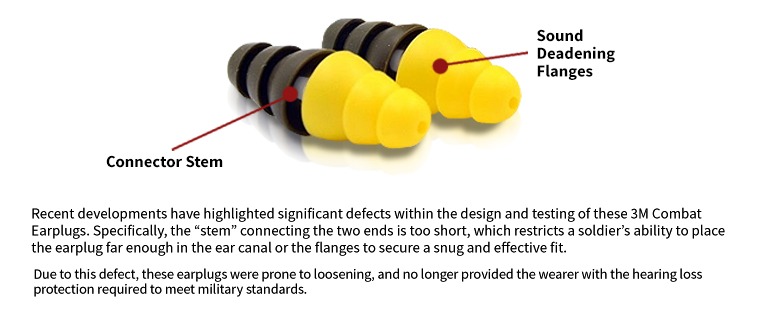3M Combat Earplug
3M Dual-Ended Combat Arms™ Earplugs, Version 2 (CAEv2) Are Defective and Dangerous
For more than twelve years (from 2003 to late 2015), 3M Company, or “3M” sold over 2.25 million pairs of its dual-ended Combat Arms™ earplugs to the U.S. military, generating $9 million in sales in 2006, alone. In fact, starting in 2004, all soldiers deployed to Iraq and Afghanistan were issued a set of Combat Arms™ Earplugs. Originally designed and manufactured by Aearo Technologies, Inc. (“Aearo”), which was later purchased by 3M in 2008, these dual-ended earplugs were designed to provide soldiers with a single set of earplugs capable of serving two purposes.
Insertion into the ear in the “open” position (yellow end in), was supposed to block, or significantly decrease, loud sounds, such as battlefield explosions, all the while still affording soldiers the ability to hear quieter noises (e.g. officer commands, communications with fellow soldiers). Insertion into the ear in the “closed” position (green end in), was supposed to block all sounds, much like traditional earplugs. However, recent developments have spotlighted significant defects within the design and testing of these earplugs. More specifically, the white “stem” that connects the yellow and green end of each earplug is too short, thereby restricting the soldier’s ability to place the earplug far enough into the ear canal to secure a snug fit. Consequently, and unbeknownst to wearers, the earplugs have the ability to loosen, no longer providing the protection from hearing loss required to meet the military standard promised and expected.

3M Knew Its Combat Arms™ Earplugs Would Not Protect Soldiers from Hearing Loss
In July of 2018, 3M agreed to pay $9.1 million to resolve a lawsuit pursued by the U.S. Department of Justice, which among other claims, alleged that 3M knowingly sold a defective product (its dual-ended Combat Arms™ earplugs) to the U.S. military, violating the Fair Claims Act. The details of this complaint revealed that the U.S. military has certain standards (“Salient Characteristics”) with regard to protective hearing devices, like the Combat Arms™ earplugs. As such, 3M/Aearo was required to test the earplugs to ensure that they had an adequate noise reduction rating (“NRR”).
Testing of the earplugs started in 2000 and revealed unacceptable NRRs for both (open and closed) ends of the earplugs. Despite, the -2 NRR revealed by testing of the “open” end (yellow end in) (a -2 NRR actually suggests noise amplification and can lead to hearing loss), 3M/Aearo thereafter inexplicably included a 0 NRR for the “open” end of the earplug on product labeling and packaging.
As for the “closed” end (green end in), testing revealed an NRR of 10.9, which was far less than the industry standard (22 NRR). Accordingly, a second study was performed of the “closed” end, only this time, the test subjects folded back the flaps of the yellow end, which elongated the stem, and made for a more secure fit of the “closed” end within the ear canal. As a result of this manipulated fit study, 3M/Aearo was able to achieve the required 22 NRR. Unfortunately, however, 3M/Aearo failed to include instructions regarding the required manipulation for the “closed” end in its packaging, intentionally subjecting its users to potential hearing loss.
Despite knowledge of these test results, in 2003, 3M/Aearo submitted a bid to the U.S. military in response to the military’s request for dual-ended earplugs, certifying that, in addition to its testing thereof, the NRRs of its earplugs met industry standards. Thereafter, 3M continued to bid contracts for earplugs, each time certifying its dual-ended Combat Arms™ earplugs satisfied the military’s Salient Characteristics, becoming the military’s exclusive supplier of dual-ended earplugs from 2003, to 2012. Thus, knowingly putting thousands of American soldiers at risk for debilitating hearing loss and other serious injuries.
Soldiers Suffering Permanent Hearing Loss Following Use of Dual-Ended Combat Arms™ Earplugs Are Entitled to Compensation From 3M
Amidst all of the gunfire, explosions, jet engines, heavy military machinery, and other loud noises inherent with being a U.S. soldier, hearing loss is a very foreseeable harm. Aware of this risk, the military set standards for its soldiers’ combat ear protection. Believing 3M’s dual-ended Combat Arms™ earplugs comported with these standards, the military issued a set of these earplugs to all soldiers deployed to Afghanistan and Iraq, and were otherwise even made available to soldiers who were not deployed. As a result, anyone enlisted in any branch of the military may have been provided defective dual-ended Combat Arms™ earplugs (CAEv2).
The Department of Veteran Affairs reports spending over $1 billion each year treating over 800,000 veterans who have already been determined to suffer from permanent hearing loss, and one and a half million more who have been diagnosed with tinnitus (ringing in the ears). Those suffering with these impairments are much more likely to also be diagnosed with other related medical conditions and losses, including:
- Auditory processing disorder
- Post-Traumatic Stress Disorder
- Depression
- Loss of earning capacity
- Future costs of hearing aids
The Yost Legal Group Can Help You Recover the Compensation You Deserve
Currently, The Yost Legal Group is investigating defective 3M dual-ended Combat Arms™ earplug claims from all 50 states. Therefore, if you or a loved one has served in the U.S. military between 2003-2015, and have been diagnosed with permanent hearing loss or tinnitus, please contact our dangerous device attorneys today at 1-800-YOST-LAW for a free consultation; you may be entitled to compensation. There is no fee or expense unless you recover.
